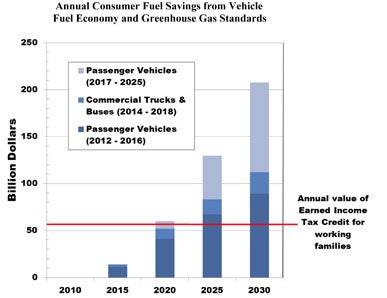This is a big week for major events, from State of the Union address last night to the Super Bowl this weekend.
But there’s one more milestone you might not have heard of yet — America is poised to make major progress in crossing the goal line to cleaner cars and cleaner gasoline.
The Tier 3 tailpipe and low sulfur gasoline standards are undergoing final review now at the White House.
Tier 3 standards will pave the way for a fleet of cleaner cars beginning in model year 2017 by reducing the emissions that contribute to dangerous soot and smog.
You can read more about what Tier 3 is and why it matters here.
Cars and light trucks are the second largest emitters of oxides of nitrogen and volatile organic compounds in the U.S. Those are the primary pollutants that form ozone.
According to EPA, the Tier 3 standards as proposed would slash the level of those pollutants by 80 percent.
By 2030, the Tier 3 standards will prevent 2,400 deaths every year, prevent tens of thousands of cases of respiratory illnesses in children, and provide total health-related benefits worth up to $23 billion per year.
The proposed Tier 3 standards would also establish a 70 percent tighter standard for particulate matter.
Particulate matter, more commonly known as soot, is one of the most dangerous types of air pollution. It has been linked to asthma attacks, bronchitis, heart attacks and other types of heart and lung diseases.
We need your help ensuring these clean air protections for our communities and families cross the goal line.
The Tier 3 standards enjoy wide support from states, businesses, public health associations, environmental groups, environmental justice organizations, and auto manufacturers.
Here are some of their comments:
The Alliance of Automobile Manufacturers and the Association of Global Automakers said:
Sulfur inhibits the catalytic converter’s ability to reduce vehicle emissions, so lower sulfur at the pump means fewer exhaust emissions in the air. And because lower sulfur reduces emissions from all vehicles, the proposed sulfur reductions would achieve Day One benefits, immediately reducing emissions from every gasoline-powered vehicle on our roads, no matter how old.
Labor groups such as the United Auto Workers have also weighed in with their strong support:
Upon full implementation, the proposed rule will reduce the amount of sulfur in our gasoline by two-thirds. This is one of the most cost-effective ways for us to get cleaner and healthier air while strengthening our domestic auto sector and creating thousands of new jobs.
A broad coalition of health organizations – including the American Academy of Pediatrics, the American Heart Association, the American Lung Association, the American Public Health Association, the American Thoracic Society, the Asthma and Allergy Foundation of America, Trust for America’s Health, Healthcare Without Harm, and the National Association of City and County Health Officials – had this to say:
These standards are urgently needed and will help protect the health of millions of Americans who continue to breathe unsafe air … Abundant scientific evidence exists on the health effects of ozone, particulate matter and other pollutants from tailpipe exhaust. Tier 3 standards will be effective tools to reduce such pollution and improve air quality.
National Association of Clean Air Agencies said:
The emission reductions that would result from the Tier 3 program proposed by EPA will benefit the citizens in every state and locality across the country… State and local air pollution agencies are relying on EPA to adopt the Tier 3 rule.
Please join the hundreds of thousands of Americans who are lending their strong support to ensure these clean car standards cross the goal line and deliver super health benefits for our nation.










